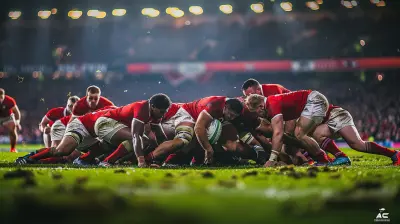The Future of Esports Broadcasting: Trends to Watch
14 July 2025
If you told someone 15 years ago that millions would tune in to watch other people play video games, they might have laughed. Fast forward to today? Esports broadcasts are pulling in bigger audiences than some traditional sports. It's no longer just about the game—it's about the experience. But what’s next?
In this article, we’re diving deep into the future of esports broadcasting. Whether you’re a die-hard fan, an up-and-coming streamer, or just esports-curious, let’s break down the trends you need to keep your eyes on.
The Rise of Personalized Viewing Experiences
Let’s be real. Traditional sports broadcasts can feel a bit... rigid. You’re stuck with one camera angle, one set of commentators, and zero control over what you're seeing.Now imagine watching your favorite esports match and switching between five different player perspectives with a tap. Want the caster to be more analytical or more hype? You choose. This is the direction esports broadcasting is heading—fully personalized experiences.
Thanks to platforms like Twitch and YouTube Gaming, viewers already get a taste of this. But with AI and better UI/UX design on the horizon, expect even more control handed to the viewer.
Key Takeaway: Viewers want to feel in the game, and personalization is the vehicle to get there.
Augmented Reality and Virtual Reality Integration
What if I told you that in a few years you could sit courtside at League of Legends Worlds or hover above the battlefield in a Dota 2 final—all from your living room?AR and VR are no longer sci-fi fluff. These tools are steadily creeping into esports broadcasts to deliver immersive experiences. Picture this:
- A VR headset that drops you right into the player’s POV.
- AR overlays that let you see in-game stats popping up in your physical space.
- Interactive 3D replays where you can spin, zoom, and analyze plays like a pro coach.
Companies are investing serious cash into this. And with tech catching up quickly, it’s not a question of if, but when this becomes the norm.
Why it matters: In an era of short attention spans and sensory overload, immersive experiences are king.
AI-Powered Commentating and Analytics
Let’s face it, as much as we love our favorite casters, sometimes a match needs a boost—whether that’s real-time highlight reels, automatic stat breakdowns, or even a commentary style tailored to noobs or hardcore fans.Enter AI.
Imagine an AI system that:
- Provides live analytics that update every second.
- Picks out highlight-worthy moments as they happen and packages them instantly.
- Adapts commentary based on your skill level or interest.
Some startups are already dabbling in this tech with promising results. Human casters aren’t going away (thankfully), but AI is becoming their powerful sidekick.
Bottom line: AI in esports broadcasting is like having a super-intelligent scoreboard that keeps the game engaging, insightful, and fast-paced.
Mobile-First Broadcasting
Not to sound all “boomer,” but remember when watching stuff on your phone felt like a last resort? Yeah, those days are long gone. Now, mobile is king.With platforms optimizing for small screens and offering vertical video formats, esports content is being reimagined for mobile consumption. Players, leagues, and content creators are crafting shorts, tapping into TikTok trends, and live streaming exclusively for mobile viewers.
But it goes beyond just format—mobile broadcasting offers:
- Touchscreen interactivity (like tapping to change camera angles)
- In-stream reactions and community polls
- Instant social sharing
Mobile-first isn’t just a trend—it’s the direction the whole ship is sailing toward.
Take note: If it's not optimized for mobile, it’s already behind.
Interactive Livestreaming and Gamification
Let’s flip the script. What if viewers didn’t just watch the game but played along?Livestreams are getting way more interactive. Think real-time predictions, fantasy drafts during matches, or earning points for correct calls. Some platforms are even tying in NFT rewards or unlocking in-game items just by watching.
Viewers stick around longer when they have something to do—not just something to watch. It’s like turning a passive stream into an active game.
Real talk: The more fans engage, the more they stay. Broadcasters are catching on fast.
Cross-Platform Streaming and Co-Streaming
Streaming used to be a battlefield. Twitch vs. YouTube vs. Facebook Gaming. But now? Esports orgs and leagues are starting to realize: why choose one platform when you can be on all of them?Cross-platform streaming ensures no fan is left behind, regardless of where they prefer to watch. And then there’s co-streaming—where influencers host watch parties of official broadcasts, adding their own flavor and pulling in niche audiences.
It’s a win-win:
- Fans get varied perspectives.
- Broadcasters get organic reach.
- Creators get engagement gold.
As more platforms embrace open rights for co-streaming, expect this trend to explode.
Here’s the kicker: Esports thrives on community—and co-streaming builds it, one watch party at a time.
More Focus on Storytelling and Content Around the Game
Think about your favorite movie. Why do you love it? Not just because of the action, but because you cared about the characters.Esports is no different.
Sure, a clutch play is thrilling. But what really hooks fans is the story behind the play—rivalries, comebacks, underdogs, redemption arcs. Broadcasters are catching on, dedicating more airtime to pre-game stories, behind-the-scenes content, and player profiles.
This narrative approach makes the game matter more. Suddenly, it’s not just a kill or a point—it’s a career-defining moment.
Pro tip: Great storytelling transforms matches into moments.
Localization and Global Reach
Esports is global by nature, but that doesn’t mean one-size-fits-all. Broadcasting is starting to get hyper-local. Think region-specific streams with:- Native-language commentary
- Local influencers co-hosting
- Culturally relevant memes and humor
Games like Valorant and Overwatch already offer multi-language streams with tailored overlays. By speaking fans’ languages (literally and metaphorically), broadcasters build loyalty and drive international growth.
Why it matters: Local vibes, global tribes.
ESG and Inclusive Representation on Stream
Let’s not forget—who’s telling the story matters as much as the story itself.There’s a growing push in esports (and sports in general) to spotlight diverse voices. That means:
- More women and minority casters
- Better accessibility features (closed captions, color-blind friendly UIs)
- Content that reflects the global makeup of the community
Audiences today care about who’s on-screen and what they represent. The future of broadcasting isn’t just more diverse—it’s authentically inclusive.
The future’s brightest when everyone’s in the frame.
Blockchain and Ownership of Broadcast Moments
Now we’re getting techy, but hang with me.What if you could “own” a clip of your favorite esports moment? Blockchain tech is making that possible, creating a collectible economy around broadcasts.
Fans could:
- Buy and trade highlight clips as NFTs
- Earn exclusive content for supporting a stream
- Verify ownership of one-of-a-kind moments
While still new (and kinda polarizing), blockchain broadcasting could redefine fan engagement and monetization.
It’s like baseball cards... but for Twitch clips. Wild, right?
Final Thoughts: The Game’s Just Getting Started
Esports broadcasting is evolving at lightspeed. What started with shaky streams and static cams is now a booming industry blending tech, creativity, and culture.From personalized content and VR integration to AI and blockchain, the future promises a more immersive, inclusive, and interactive way to watch the games we love. Whether you’re tuning in on your phone from a bus stop or wearing a VR headset in your man cave, one thing’s certain:
Broadcasting isn’t just about showing the game—it’s about changing the game.
So buckle up. The best seats in the house might soon be digital, dynamic, and completely customized just for you.
all images in this post were generated using AI tools
Category:
EsportsAuthor:

Uziel Franco
Discussion
rate this article
1 comments
Evelyn Whitaker
Excited to level up our viewing experience! 🎮 Can’t wait to see how esports broadcasting evolves—bring on the epic matches!
July 25, 2025 at 2:23 AM

Uziel Franco
Thank you! We’re excited too—there’s so much potential for innovation in esports broadcasting! 🎮


